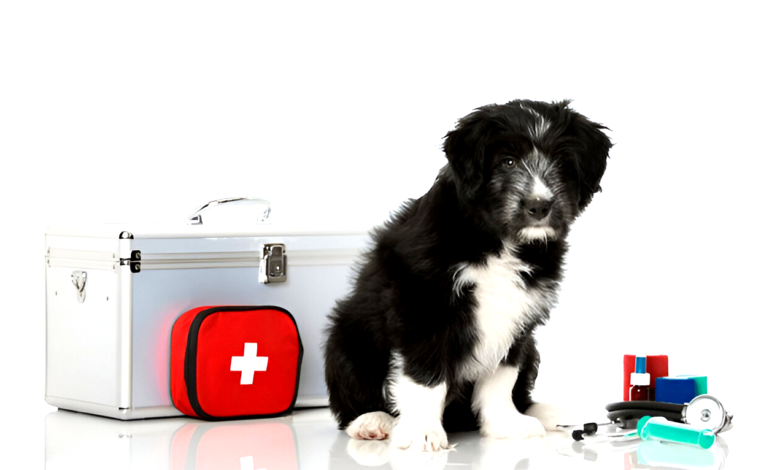
Pet First Aid 101: What to Do in an Emergency
Accidents and emergencies can happen at any time, and as a pet owner, knowing how to administer first aid can be lifesaving.
Accidents and emergencies can happen at any time, and as a pet owner, knowing how to administer first aid can be lifesaving. Whether it’s a minor cut, choking, or a more severe medical crisis, having the knowledge to respond quickly and effectively is crucial. Pet first aid involves immediate care given to an injured or ill pet before professional veterinary help is available. Being prepared and understanding basic first aid techniques can make a significant difference in your pet’s recovery and well-being.
Understanding pet first aid means knowing how to assess a situation, provide emergency care, and determine when veterinary intervention is necessary. Pets, like humans, can experience a variety of health crises, including poisoning, heatstroke, and broken bones. By equipping yourself with first aid skills, you can reduce pain, prevent further injury, and potentially save your pet’s life. This guide covers essential pet first aid techniques, common emergencies, and how to create a pet first aid kit to ensure you are always prepared.
Understanding Pet Emergencies
Recognizing a pet emergency is the first crucial step in providing timely care. Pets cannot communicate their pain verbally, so it is important to be observant of any unusual behaviors or symptoms that indicate distress. Difficulty breathing, excessive bleeding, seizures, sudden collapse, unresponsiveness, vomiting or diarrhea with blood, severe limping, swollen or bloated abdomen, and signs of extreme pain such as whining or aggression may indicate a medical emergency. If your pet exhibits any of these symptoms, immediate action and professional veterinary care are required.
When faced with a pet emergency, staying calm is essential. The first steps include assessing the severity of the situation, ensuring your safety since an injured pet may react aggressively due to pain, and calling your veterinarian or an emergency pet clinic for immediate guidance. Administering basic first aid, such as stopping bleeding, stabilizing fractures, or performing CPR, can be lifesaving while waiting for professional help. If transportation is required, using a blanket or pet carrier to minimize movement and stress will help keep the pet secure.
Common Pet Emergencies and How to Handle Them
Choking is one of the most frightening emergencies pet owners can face. If your pet is choking, they may paw at their mouth, cough, gag, or struggle to breathe. You should carefully open their mouth and look for an obstruction. If you can see it, use tweezers to gently remove it. If removal is not possible, perform the Heimlich maneuver by applying quick, firm pressure to the abdomen. Seeking veterinary attention immediately is crucial to ensure there is no remaining obstruction.
Bleeding and wounds require prompt attention to prevent excessive blood loss and infection. Applying direct pressure using a clean cloth or gauze will help stop bleeding. If the wound is deep or punctured, covering it and heading straight to a veterinarian is the best course of action. Avoid removing objects embedded in the wound, as this may worsen bleeding.
Broken bones or fractures can cause immense pain, and your pet may refuse to move or bear weight on the injured limb. Keeping your pet as still as possible is important to avoid further damage. Do not attempt to reset the bone. Instead, gently wrap the injured limb in a towel for support and transport your pet to the vet for professional care.
Heatstroke is another common emergency, especially in hot weather. Symptoms include excessive panting, drooling, weakness, vomiting, and collapse. If you suspect heatstroke, immediately move your pet to a cool, shaded area and offer small amounts of water. Cooling the body with damp towels or cool water on the paws and body can help regulate temperature. However, using cold water can cause shock, so avoid drastic temperature changes. Seeking veterinary care is necessary to ensure internal organs are not affected.
Poisoning is a critical emergency that requires immediate action. If you suspect your pet has ingested something toxic, look for symptoms such as vomiting, drooling, seizures, or difficulty breathing. Identifying the substance consumed can help the vet determine the best treatment. Calling your vet or a pet poison helpline is the best course of action. Inducing vomiting should only be done under professional guidance, as some substances can cause more harm if vomited.
Seizures in pets can be distressing to witness. A pet experiencing a seizure may shake uncontrollably, foam at the mouth, or collapse. During a seizure, it is important to keep the pet away from objects that could cause injury. Do not attempt to restrain them. Time the seizure and monitor their breathing. Once the seizure ends, keep them calm and contact your veterinarian to discuss the next steps.
Eye injuries require delicate handling. If your pet has an eye injury, avoid touching or applying pressure to the eye. Flushing the eye with saline solution can help remove debris. Prevent your pet from rubbing the affected eye and seek veterinary attention immediately to prevent potential long-term damage.
Creating a Pet First Aid Kit
A well-stocked pet first aid kit ensures you are always prepared to handle emergencies efficiently. The kit should include essential items such as gauze, bandages, antiseptic wipes, tweezers, scissors, a digital thermometer, hydrogen peroxide (only for specific poisonings under veterinary guidance), saline solution, and pet-safe pain relievers prescribed by a vet. Keeping emergency contact numbers for your vet, poison control, and nearby animal hospitals in your kit is also important. Regularly checking and replenishing your supplies will keep your first aid kit ready for any situation.
Read More: Pet First Aid: Providing Basic Medical Care in Emergency Situations
Conclusion
Being prepared for pet emergencies is not just about reacting in the moment—it’s about equipping yourself with the knowledge and resources to handle any situation with confidence. Emergencies can happen when you least expect them, and your quick response can make the difference between a minor issue and a life-threatening crisis. By understanding common emergencies and learning basic first aid skills, you can minimize your pet’s pain, prevent further injury, and potentially save their life. However, while first aid can provide immediate relief, it should never replace professional veterinary care. Seeking medical attention after administering first aid ensures that your pet gets the best possible treatment and long-term recovery.
As a responsible pet owner, taking the time to prepare can bring peace of mind and strengthen the bond you share with your furry companion. Keeping a well-stocked first aid kit, knowing emergency contact numbers, and staying informed about potential hazards in your environment are all steps you can take to safeguard your pet’s health. Being proactive about pet first aid is one of the most loving and responsible things you can do for your pet, ensuring they receive the care they need in critical moments. By staying calm, prepared, and informed, you can provide your pet with the best chance of overcoming emergencies and living a happy, healthy life.
FAQs
If my pet is unconscious, what should I do?
Checking their breathing and pulse is crucial. If they are not breathing, performing CPR and rushing them to the vet immediately can be lifesaving.
Can I give my pet human medicine for pain relief?
No, many human medications are toxic to pets. Always consult a veterinarian before administering any medication.
How should I transport an injured pet safely?
Using a sturdy surface like a blanket or board will minimize movement and provide stability while transporting them.
What should I do if my pet gets stung by a bee?
Removing the stinger if visible, applying a cold compress, and monitoring for allergic reactions are important steps to take.
How can I prevent pet emergencies?
Keeping hazardous items out of reach, supervising pets outdoors, and scheduling regular veterinary check-ups can help prevent many emergencies.







